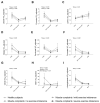Biomarkers of Redox Balance Adjusted to Exercise Intensity as a Useful Tool to Identify Patients at Risk of Muscle Disease through Exercise Test
- PMID: 35565853
- PMCID: PMC9105000
- DOI: 10.3390/nu14091886
Biomarkers of Redox Balance Adjusted to Exercise Intensity as a Useful Tool to Identify Patients at Risk of Muscle Disease through Exercise Test
Abstract
The screening of skeletal muscle diseases constitutes an unresolved challenge. Currently, exercise tests or plasmatic tests alone have shown limited performance in the screening of subjects with an increased risk of muscle oxidative metabolism impairment. Intensity-adjusted energy substrate levels of lactate (La), pyruvate (Pyr), β-hydroxybutyrate (BOH) and acetoacetate (AA) during a cardiopulmonary exercise test (CPET) could constitute alternative valid biomarkers to select "at-risk" patients, requiring the gold-standard diagnosis procedure through muscle biopsy. Thus, we aimed to test: (1) the validity of the V'O2-adjusted La, Pyr, BOH and AA during a CPET for the assessment of the muscle oxidative metabolism (exercise and mitochondrial respiration parameters); and (2) the discriminative value of the V'O2-adjusted energy and redox markers, as well as five other V'O2-adjusted TCA cycle-related metabolites, between healthy subjects, subjects with muscle complaints and muscle disease patients. Two hundred and thirty subjects with muscle complaints without diagnosis, nine patients with a diagnosed muscle disease and ten healthy subjects performed a CPET with blood assessments at rest, at the estimated 1st ventilatory threshold and at the maximal intensity. Twelve subjects with muscle complaints presenting a severe alteration of their profile underwent a muscle biopsy. The V'O2-adjusted plasma levels of La, Pyr, BOH and AA, and their respective ratios showed significant correlations with functional and muscle fiber mitochondrial respiration parameters. Differences in exercise V'O2-adjusted La/Pyr, BOH, AA and BOH/AA were observed between healthy subjects, subjects with muscle complaints without diagnosis and muscle disease patients. The energy substrate and redox blood profile of complaining subjects with severe exercise intolerance matched the blood profile of muscle disease patients. Adding five tricarboxylic acid cycle intermediates did not improve the discriminative value of the intensity-adjusted energy and redox markers. The V'O2-adjusted La, Pyr, BOH, AA and their respective ratios constitute valid muscle biomarkers that reveal similar blunted adaptations in muscle disease patients and in subjects with muscle complaints and severe exercise intolerance. A targeted metabolomic approach to improve the screening of "at-risk" patients is discussed.
Keywords: Liquid Chromatography tandem Mass Spectrometry (LC-MS/MS); cardiopulmonary exercise test (CPET); exercise intolerance; maximal oxygen uptake; metabolomics; myopathy; tricarboxylic citric acid cycle.
Conflict of interest statement
The authors declare no conflict of interest.
Figures



Similar articles
-
Spiroergometric parameters at maximal exercise testing assessed functional respiratory impairment in asbestos-induced fibrosis.Clin Respir J. 2014 Apr;8(2):175-84. doi: 10.1111/crj.12055. Epub 2013 Nov 28. Clin Respir J. 2014. PMID: 24028216
-
Relationship between daily physical activity and aerobic fitness in adults with cystic fibrosis.BMC Pulm Med. 2015 May 9;15:59. doi: 10.1186/s12890-015-0036-9. BMC Pulm Med. 2015. PMID: 25952747 Free PMC article.
-
[Incremental stress test: comparison between protocols and cardiorespiratory reference values in healthy workers].G Ital Med Lav Ergon. 2001 Jan-Mar;23(1):5-11. G Ital Med Lav Ergon. 2001. PMID: 11386187 Italian.
-
Using Cardiopulmonary Exercise Testing to Understand Dyspnea and Exercise Intolerance in Respiratory Disease.Chest. 2022 Jun;161(6):1505-1516. doi: 10.1016/j.chest.2022.01.021. Epub 2022 Jan 19. Chest. 2022. PMID: 35065052 Review.
-
Type 2 diabetes and reduced exercise tolerance: a review of the literature through an integrated physiology approach.Cardiovasc Diabetol. 2020 Sep 5;19(1):134. doi: 10.1186/s12933-020-01109-1. Cardiovasc Diabetol. 2020. PMID: 32891175 Free PMC article. Review.
Cited by
-
Physical Exercise or Activity and Energy Balance or Metabolism in the Context of Health and Diseases.Nutrients. 2023 Nov 24;15(23):4909. doi: 10.3390/nu15234909. Nutrients. 2023. PMID: 38068767 Free PMC article.
-
Development and validation of a multiplexed LC-MS/MS ketone body assay for clinical diagnostics.J Mass Spectrom Adv Clin Lab. 2024 Jan 23;31:49-58. doi: 10.1016/j.jmsacl.2024.01.004. eCollection 2024 Jan. J Mass Spectrom Adv Clin Lab. 2024. PMID: 38375486 Free PMC article.
-
Mass Sportrometry: An annual look back at applications of mass spectrometry in sport and exercise science.Anal Sci Adv. 2023 Mar 31;4(3-4):60-80. doi: 10.1002/ansa.202300003. eCollection 2023 May. Anal Sci Adv. 2023. PMID: 38715927 Free PMC article. Review.
-
Is maximal oxygen consumption an appropriate metric for metabolic health?Eur J Appl Physiol. 2025 Sep;125(9):2409-2413. doi: 10.1007/s00421-025-05875-2. Epub 2025 Jul 3. Eur J Appl Physiol. 2025. PMID: 40610786 Free PMC article. Review.
References
MeSH terms
Substances
LinkOut - more resources
Full Text Sources
Medical

